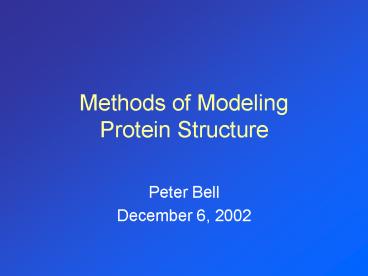Methods of Modeling Protein Structure - PowerPoint PPT Presentation
1 / 12
Title:
Methods of Modeling Protein Structure
Description:
Comparative Modeling based on similarities from evolution ... After finding similar sequences, a structure is modeled using that related sequence. ... – PowerPoint PPT presentation
Number of Views:79
Avg rating:3.0/5.0
Title: Methods of Modeling Protein Structure
1
Methods of ModelingProtein Structure
- Peter Bell
- December 6, 2002
2
3-D Structure of Proteins
- Structure of natural proteins guided by 2 sets of
principles on vastly different time scales - Laws of Physics
- Chemical bonds, H-bonds, electonic interactions
- Theory of Evolution
- Families of similar proteins share similar
sequences, structure, and often function
3
Modeling Proteins
- Two general methods to modeling
- Each based on either of the principles governing
3-D structure - Comparative Modeling based on similarities from
evolution - De novo or ab initio based on physicsenergies
4
Comparative Methods
- Four Main Steps in this process
- Finding known structures related to the target
sequence being modeled. (finding templates) - Aligning sequence with known structures
- Building a model
- Assesing the model
5
Comparative Modeling
- Finding Templates
- 3-D structures are more conserved that primary
sequences through evolution - Proteins with similar sequences will often share
structural characteristicsfind using sequence
comparison methods such as PSI-BLAST - Sometimes, very different sequences will share
structurefind these using the Protein Data Bank
(makes use of coarse structures for quick
comparisons)
6
Comparative Modeling
- Building the model
- After finding similar sequences, a structure is
modeled using that related sequence. - Core regions are kept intact (helices, sheets)
- Loops and side chains using various methods to
minimize energies in the presence of the core
regions. - Three main methods
- Loops and side chains based on alignment to
related sequences in other proteins - Approx. position of atoms is calculated from
approx. position of conserved atoms in template. - Distance Geometry or spatial restraints are
optimized
7
Comparative Modeling
- Assesing the Model
- Accuracy associated with the percent of the
sequence that matches the template - Most errors in side chains or in loops
- These are mostly insignificant as these parts
dont effect function. - Other errors include small shifts and distortions
in other parts of the protein - Error increases rapidly below 30 sequence
similarity
8
De novo Prediction
- Can be done with any proteinno other members of
the family need be known - Based on assumption Native State is at the
global free energy minimum - A large scale search is carried out to find this
minimum with tertiary structure.
9
De novo Prediction
- Two key components in finding minimum
- Methods for carrying out search efficiently
- Free energy function used to calculate energy
- Complexity of these increases as computing power
increases - Often only a subset of actual atoms in a protein
is modeled (leave out hydrogen, for example) - The potential functions must then account for
these absent atoms. - Some newer methods flip certain sequences into
possible secondary structures, calculate energy,
then find how these fit into tertiary structure
10
De novo Prediction
- Accuracy is much lower than comparative methods
(with gt30 sequence similarity) - Basic structure can still be determined
reasonably well with 150 amino acids or less - Accuracy too low if high-resolution info is
needed. - Low-resolution info is useful in finding
structural and functional relationships no
apparent by comparison of AA sequence.
11
Summary
- Two methods available to model proteins based on
their AA sequence - Comparative Theory of Evolution
- De novo Laws of Physics
- Comparative more accuratebut requires other
structures to be known - De novo can be used for any protein but requires
more computing power and wont produce highly
accurate models.
12
References
- Baker, D. Sali, A. Protein Structure Prediction
and Structural Genomics. Science 2001, 294,
93-96. - Fiser, A. Feig, M. Brooks, C. L. Sali, A.
Evolution and Physics in Comparative Protein
Structure Modeling. Acc. Chem. Res. 2002, 35,
413-421.































